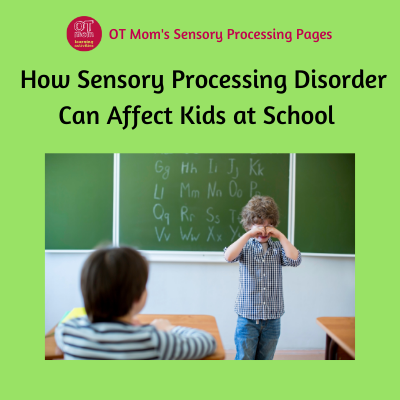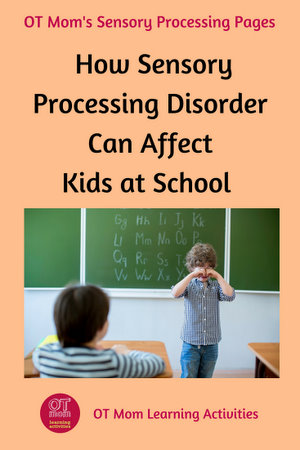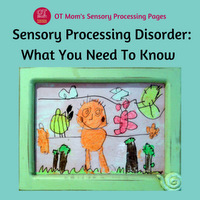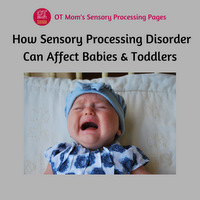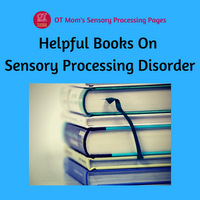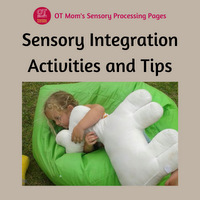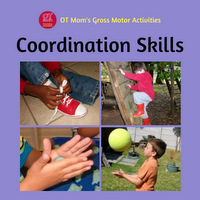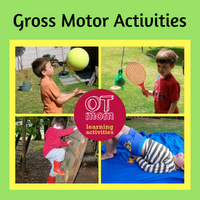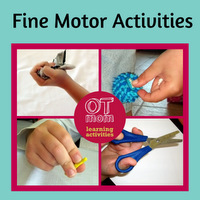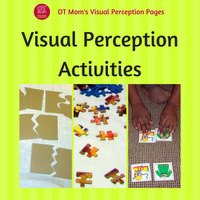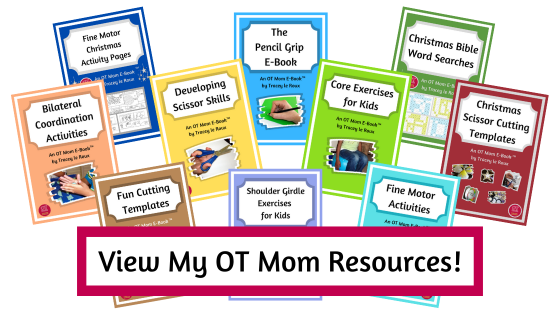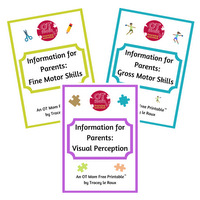- Home Page
- Overview of Sensory Processing
- Sensory Processing Disorder in Children
Sensory Processing Disorder in Children At School
Sensory processing disorder in children is becoming more recognized among health professionals and educators. These children are often misunderstood and may be incorrectly labeled as ADD, learning disabled, slow, clumsy or naughty.
On this page, I highlight some of the ways that sensory processing disorder may affect learning, looking at the different aspects of SPD and how it may affect a child in the classroom. I also suggest a few coping strategies but I really recommend an occupational therapy evaluation if you are concerned about your child.
Identifying your child's specific areas of challenge is a vital first step towards helping your child achieve their best learning experience.
I sometimes link to products (#Ad) that are similar to those I use and love. If you do purchase something through my links, I will receive a small commission that helps support my site - thank you!
Key Takeaways For Busy Parents:
- Sensory integration and processing differences can show up in different ways, including in the areas of sensory modulation, motor skills and sensory discrimination skills.
- This can affect attention, behavior and ability to learn effectively.
- Effective strategies can include sensory-friendly classroom modifications, activities to regulate the senses, and possibly using supportive tools like weighted vests and fidgets.
- If you are concerned, then an occupational therapy evaluation is recommended: this will provide targeted guidance and intervention specifically for your child.
Sensory Modulation Disorder In The Classroom
Sensory modulation disorder may present in different ways - it is important to understand that children who have been identified as struggling with sensory modulation, may sometimes show this in different ways on different days.
1) A Sensory Defensive Child
A sensory defensive child may be extremely fussy about the textures of school clothing and shoes, smells in the environment, the brightness of the lights and the noise (oh, the bells!!!). They may avoid playground activities for fear of being jostled or bumped, or because they dislike movement and heights.
Standing or sitting in close proximity to other children can be stressful owing to the possibility of unexpected touch and jostling. This child may also be easily distracted during seat work owing to not being able to screen out noises and visual stimuli.
A sensory defensive child can easily become overstimulated or overwhelmed by the information coming from from any or all of the senses and may "act out" in crying, tantrums and meltdowns. This child may end up lashing out at other kids to try and protect themselves from the over stimulation.
Coping strategies in the classroom
could include being allowed to stand at the back of the line or work at a
desk alone to reduce the possibility of being bumped, wearing a
weighted vest or blanket to give deep pressure input, having a sensory corner at home or in the classroom where calming activities are available, and using a sensory fidget.
"Max and Me"#Ad is a wonderful book that has helped many kids and their parents to develop more effective coping strategies.
2) A Sensory Under-Responsive Child
A child who is sensory under-responsive may seem to "zone out" during periods of sitting still, may be the last to respond to the teacher's instructions, and may seem slow and lethargic during classroom activities.
Coping strategies in the classroom could include activities that stimulate the vestibular system such as jumping-jacks or the "Head, shoulders, knees and toes" song, as well as getting active in ways like cleaning the board, carrying the books etc.
3) A Sensory Seeking Child
Sensory seeking children may be
constantly fidgeting and moving during class time, and often get into
trouble for impulsive behavior which disrupts their classmates.
A sensory seeking child
may struggle to do anything without excessive movement, and will be the
child who crashes and bumps into furniture, sports equipment and other
children - this is done on purpose, not maliciously, but just because it
"feels good". This child may also chew on pencils and clothing and
whatever else comes to hand!
Coping strategies in the classroom could include making sure the child has taken part in some heavy muscle activities such as sweeping the floor or carrying books. Some schools allow kids to chew gum during class; alternatively have your child eat very chewy or crunchy food at recess. Sensory fidgets#Ad can also help kids give themselves a little extra stimulation in order to concentrate a bit better.
Sensory-Based Motor Disorder In The Classroom
Children whose brains are not processing sensory information adequately, may experience delays in motor skills. The brain may be sending incomplete or inaccurate messages to the body and may result in various delays.
Balance and coordination skills may be poor, and this child may slump at the desk or on the floor owing to poor postural control.
Gross motor skills and fine motor skills may be delayed compared to their peers.
Children with a sensory based motor disorder may take a long time to learn to use eating utensils, to cut with scissors and to dress themselves.
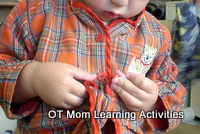 Struggling to do buttons
Struggling to do buttonsThey may be clumsy and struggle to play games and interact appropriately with other children.
Sensory Discrimination Disorder In The Classroom
Sensory Processing Disorder in children may manifest in poor sensory discrimination. This may lead to delays in
- auditory perception (understanding what they hear),
- visual perception (understanding what they see) and
- tactile perception (understanding with they can feel)
Even if your child has perfect hearing, auditory perception delays may result in (among other things) a child struggling to remember what was said, confusing similar-sounding words, and struggling to hear the teacher’s voice over the background noise in the classroom.
Even if your child has perfect 20/20 vision, visual perception delays may result in (among other things) a child struggling to copy words from the blackboard, losing his place when reading, confusing similar looking words and letters (eg b, p, d) and battling to do jigsaw puzzles.
This child may also find it hard to do regular classroom worksheets such as mazes, wordsearches and spot-the-differences.
Poor tactile perception can cause a child to be clumsy with the hands perhaps breaking things owing to squeezing too hard, or dropping things because of not holding them firmly enough.
This can affect how well a child can take part in crafty activities in the classroom.
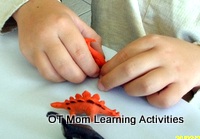 Using tactile perception
Using tactile perceptionTactile perception delays can also make cutting with scissors and handwriting more difficult, and the child may not be able to identify an object by feel instead of by sight.
Help for Sensory Processing Disorder in Children!
Remember, we all have bad days and meltdowns, and clumsy moments, and we can all relate to feeling completely overwhelmed by sensory stimulation where one more loud noise sends us running for the hills!
But when there is a constant pattern of poor responses, and a child's daily functioning is affected, particularly their ability to make the most of learning at school, then it is time to seek help.
- An occupational therapy evaluation is recommended as the first step in diagnosis of and intervention for sensory processing disorder in children.
- Ask your therapist for activities you can do at home with your child - this is often called a Sensory Diet and can help your child to learn to process sensory information more adequately in order to get a more functional response. Your OT will design a sensory diet that is specific to your child's unique needs.
- I really recommend that parents and teachers read at least one of the fantastic books on sensory processing disorder in children that are available.
In particular Max and Me(#Ad) is probably the best book written for children, about sensory processing disorder in children, so if you can track down a copy, it will be a great read for your child as well as anyone working with your child. - Take a look at these simple sensory integration activities you can incorporate into your daily life to help your child cope. Some of these make good recess activities.
Resources To Help Kids With SPD Cope At School
Here are a few resources that parents and teachers can use in the classroom to support kids who struggle with SPD:
- Fidgets can be very helpful in helping kids self-regulate their sensory responses in the classroom - they can work to calm an over-responsive child and to help an under-responsive or sensory seeking child to focus.
Tom's Flippy Fidget Chains (#Ad) are my family's own choice of fidget toys - this brand is the best quality (watch out for imitations), as well as being discreet and quiet!
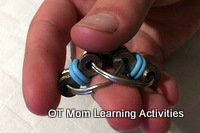 Tom's flippy fidget chain
Tom's flippy fidget chain- Hugs and deep pressure can help kids to feel more in control of their sensory issues, but it is is not always possible to provide these in the classroom! However, you can try weighted vests#Ad, weighted blankets and weighted lap blankets#Ad
and see if those help your child to stay focused during school.
- Consider creating a sensory corner or providing a sensory box for kids to make use of when they can feel themselves struggling.
- Some kids benefit from chewing gum or eating very crunchy food, while others need to chew on something more durable like special chewy pendants#Ad. Speak to your child's teacher to see what strategies can be implemented during recess and breaks in the lessons.
I hope you found this page helpful and that it gave you some insight into how sensory processing issues can affect children in school.
I hope you were also encouraged in finding some strategies that you could help your child implement - there is no one-size-fits-all solution - every child responds differently, so keep experimenting until you find what works for YOUR child.
Please sign up for my occasional newsletter to stay in touch with new articles and activities on my site!
- Home Page
- Overview of Sensory Processing
- Sensory Processing Disorder in Children
Share this page to help others!
Related Pages On My Site
Use of this website is not a substitute for occupational therapy assessment and treatment. However, you may find some of these activities helpful to support your child's development in all areas. Visit these pages on my site for inspiration, photographed activities and tips to help you help your child!
Didn't find what you were looking for? Try a search of my site!
